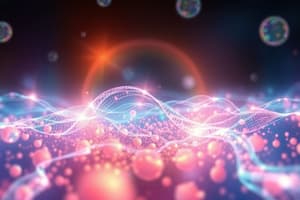Podcast
Questions and Answers
What type of transport is diffusion?
What type of transport is diffusion?
- Active
- Passive (correct)
- Facilitated
- None of the above
What direction do molecules move during osmosis?
What direction do molecules move during osmosis?
High to a low concentration
Facilitated diffusion requires energy.
Facilitated diffusion requires energy.
False (B)
What is necessary for facilitated diffusion?
What is necessary for facilitated diffusion?
What type of transport is a protein pump?
What type of transport is a protein pump?
Phagocytosis is often referred to as _____ because it involves 'cell-eating.'
Phagocytosis is often referred to as _____ because it involves 'cell-eating.'
During receptor-mediated endocytosis, substances move in what direction?
During receptor-mediated endocytosis, substances move in what direction?
What is the primary function of exocytosis?
What is the primary function of exocytosis?
Pinocytosis is a form of 'cell-drinking.'
Pinocytosis is a form of 'cell-drinking.'
Flashcards are hidden until you start studying
Study Notes
Cell Transport
-
Diffusion
- Passive transport mechanism
- Small nonpolar molecules (e.g., oxygen, carbon dioxide) pass directly through the cell membrane
- Movement occurs from high to low concentration
- No energy or proteins required
-
Osmosis
- Passive transport specifically for water
- Water moves across the cell membrane from high to low concentration
- Requires no energy or proteins
-
Facilitated Diffusion
- Passive transport helped by carrier proteins
- Moves substances like polar molecules (e.g., water) and ions (e.g., salts) down their concentration gradient
- Direction is from high to low concentration
- Does not require energy, but proteins are necessary
-
Protein Pump
- Active transport via carrier proteins using energy
- Moves substances against their concentration gradient from low to high concentration
- Energy and proteins are required
-
Receptor Mediated Endocytosis
- Active transport mechanism involving receptor proteins
- Specific substances bind to receptors, triggering endocytosis
- Direction of movement from low to high concentration
- Requires energy and proteins
-
Phagocytosis
- Active transport process also known as "cell-eating"
- Cells engulf solid materials using vesicles
- Movement is from low to high concentration
- Energy required, but proteins are not needed
-
Pinocytosis
- Active transport process also known as "cell-drinking"
- Cells take in liquids via vesicles
- Direction of transport is from low to high concentration
- Requires energy without the need for proteins
-
Exocytosis
- Active transport mechanism for expelling substances
- Waste and hormones are secreted from the cell
- Movement occurs from low to high concentration
- Requires energy but no proteins are needed
Studying That Suits You
Use AI to generate personalized quizzes and flashcards to suit your learning preferences.





